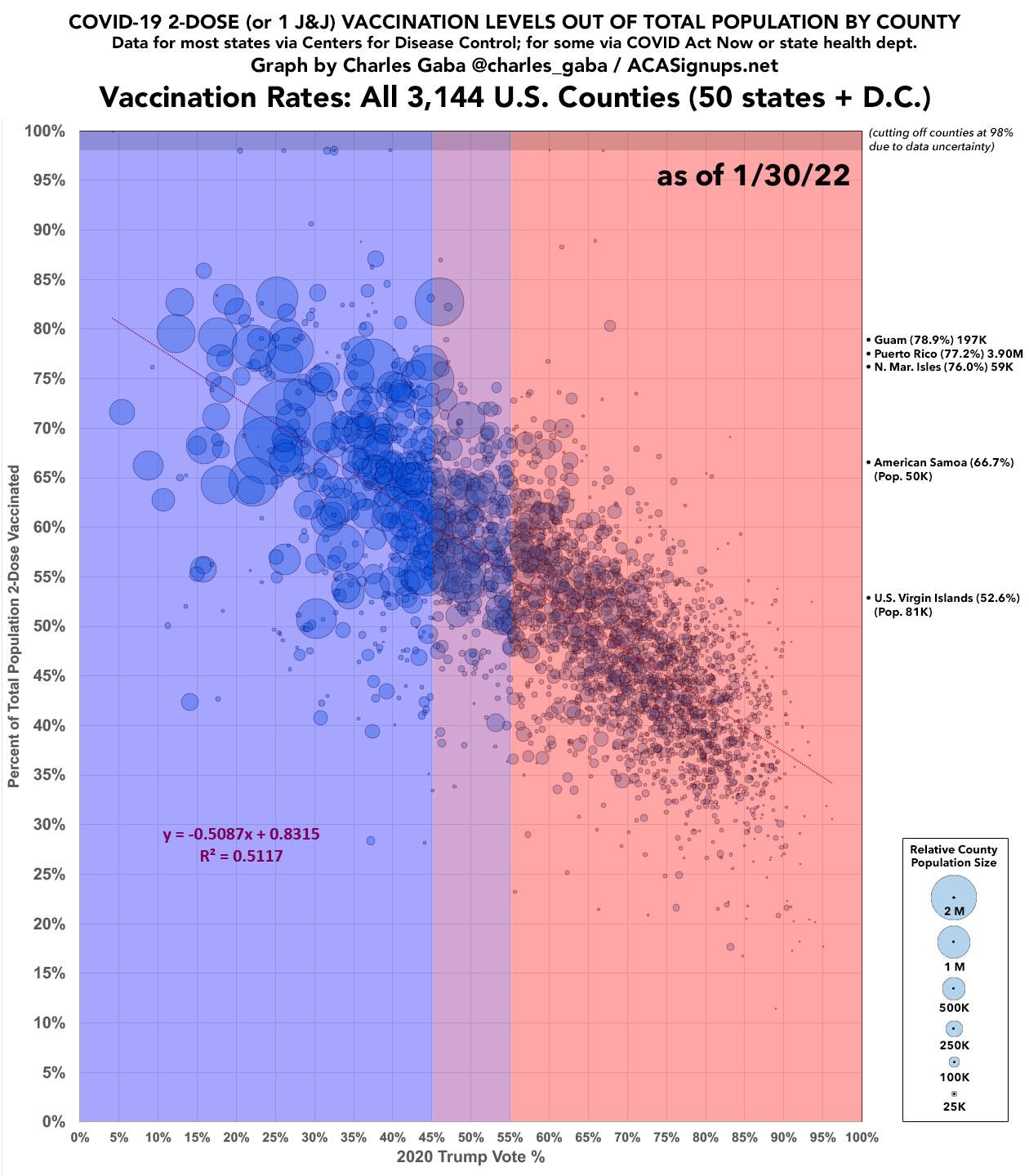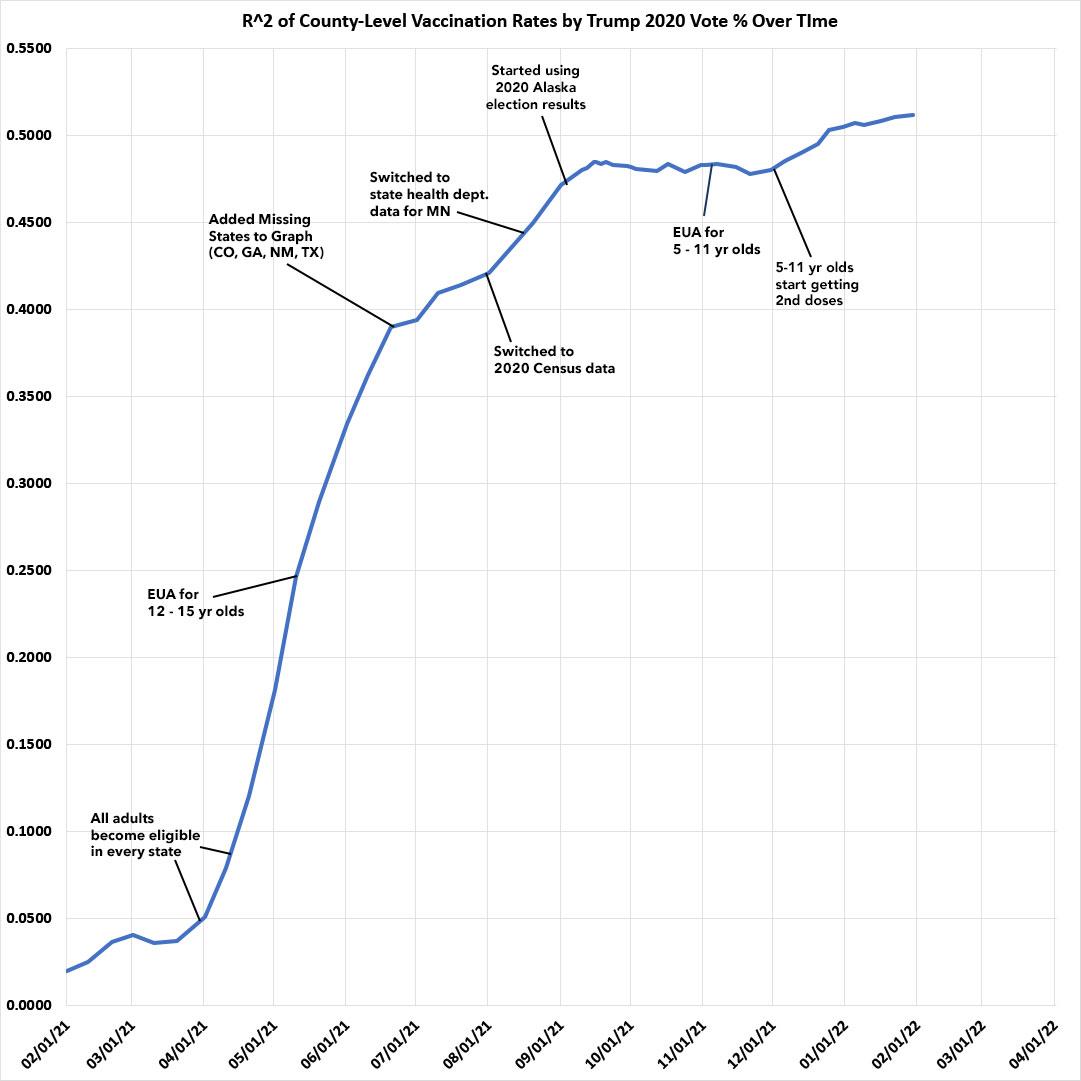Weekly Update: County-level #COVID19 vaccination levels by Partisan Lean (now w/boosters!)

Methodology reminders:
- I go by county residents who have received the 2nd COVID-19 shot only (or 1st in the case of the J&J vaccine).
- NEW: Scroll down to also see 3rd/Booster shots, with some important caveats of its own.
- I base my percentages on the total population via the 2020 U.S. Census as opposed to adults only or those over 11 years old (or even over 4 years old).
- For most states + DC I use the daily data from the Centers for Disease Control, but there are some where the CDC is either missing county-level data entirely or where the CDC data is less than 90% complete at the county level. Therefore:
- For Vermont and West Virginia, I'm using data from the COVID Act Now Risk & Vaccine Tracker database
- For Virginia, I've started using the official state health department dashboard due to some weirdness in the COVID Act Now data for VA. Unfortunately the VA Health Dept. dashboard doesn't allow you to export, view or download all 95 counties/city-counties at once, making this a tedious effort, so I'll only be updating Virginia once a month.
-
- For Colorado, Georgia, Minnesota and Texas, I'm using their COVID vaccine dashboards set up by the state health departments.
- For California, I'm using the CDC data for most counties and the state health dept. dashboard data for the 8 small counties which the CDC isn't allowed to post data for.
- For Massachusetts, I'm using the CDC data for most counties but am now using the official Massachusetts Health Dept. weekly data report for Barnstable, Dukes & Nantucket counties, which the CDC only has partial data for.
- The 5 major U.S. territories don't vote for President in the general election, preventing me from displaying them in the main graph, but I have them listed down the right side.
- Alaska's 2020 election results are estimated thanks to an updated analysis by RRH Elections (all other states +DC have been using 2020 county-level election data all along).
- BY POPULAR REQUEST, here's an updated Google Spreadsheet with all the relevant data.
- IMPORTANT: There are several counties which have supposedly surpassed 100% vaccination rates; obviously that's impossible, and is due to discrepancies in either the vaccination data or actual population counts. In addition, people have moved, died, etc. since the 2020 Census was locked in as of April 2020. With that in mind, I've started setting the maximum vaccination rate for any county at 98% with one exception: Kalawao County, Hawaii, which only has 82 residents & is a special case.
With all this in mind, here's what things looked like as of January 30th, 2022:
The most noteworthy thing is that both the R-squared and the slope have moved over the 0.5 threshold.
As I predicted back in mid-November, the most obvious reason for this is that 5 - 11 year-olds started receiving their 2nd Pfizer shot around Thanksgiving. The parents who were most likely to have gotten vaccinated themselves earlier this year are pretty clearly the ones most likely to get their children vaccinated, and the parents least likely to get vaccinated are, sadly, also those least likely to vaccinate their children either:
- There's 10 Counties where over 90% of their populations have received their 2nd shot, with ~189,000 residents, including:
- Bristol Bay, AK (pop. 844)
- Apache County, AZ (pop. 66,021)
- Santa Cruz County, AZ (pop. 47,669)
- (Note: there's a serious discrepancy between the official CDC vaxx rate & the AZ Health Dept. for both Apache & Santa Cruz)
- Kalawao County, HI (pop. 82)
- Dukes County, MA (pop. 20,600)
- Nantucket County, MA (pop. 14,255)
- Hudspeth County, TX (pop. 2,912)
- Presidio County, TX (pop. 6,131)
- Charles City, VA (pop. 6,773)
- Teton County, WY (pop. 21,073)
- There's 45 Counties where over 80% of their total populations have received their 2nd shot, with ~10.05 million residents.
- There's 168 Counties with 69.7 million residents where over 70% of the total populations have received their 2nd shot.
- 82 of these counties have more than 100,000 residents.
- At the opposite end, there's still 25 counties which have vaccinated less than 25% of their total populations, with ~261,000 residents:
- Winston County, AL (pop. 23,540)
- Crowley County, CO (pop. 5,922)
- Charlton County, GA (pop. 12,518)
- Chattahoochee County, GA (pop. 9,565)
- LaGrange County, IN (pop. 40,446)
- Cameron County, LA (pop. 5,617)
- Newton County, MO (pop. 58,648)
- Garfield County, MT (pop. 1,173)
- McCone County, MT (pop. 1,729)
- Powder River County, MT (pop. 1,694)
- Arthur County, NE (pop. 434)
- Grant County, NE (pop. 611)
- Logan County, NE (pop. 716)
- McPherson County, NE (pop. 399)
- Sioux County, NE (pop. 1,135)
- Storey County, NV (pop. 4,104)
- Billings County, ND (pop. 945)
- Grant County, ND (pop. 2,301)
- McKenzie County, ND (pop. 14,704)
- Slope County, ND (pop. 706)
- Holmes County, OH (pop. 44,223)
- Harding County, SD (pop. 1,311)
- Moore County, TN (pop. 6,461)
- Gaines County, TX (pop. 21,598)
- King County, TX (pop. 265)
- There's 16 counties with more than 100,000 residents which have vaccinated less than 40% of their total populations:
- Etowah County, AL (pop. 103436)
- Lee County, AL (pop. 174241)
- Limestone County, AL (pop. 103570)
- Shelby County, AL (pop. 223024)
- Tuscaloosa County, AL (pop. 227036)
- Matanuska-Susitna, AK (pop. 107081)
- Mohave County, AZ (pop. 213267)
- Bartow County, GA (pop. 108,901)
- Carroll County, GA (pop. 119,148)
- Lowndes County, GA (pop. 118,251)
- Muscogee County, GA (pop. 206,922)
- Paulding County, GA (pop. 168,661)
- Warren County, KY (pop. 134,554)
- Calcasieu County, LA (pop. 216,785)
- Livingston County, LA (pop. 142,282)
- Anderson County, SC (pop. 203,718)
- There are 49 counties with more than 1 million residents. Of those, the highest-vaxxed is Santa Clara, CA (83.1% vaxxed) while the lowest-vaxxed is Wayne County, MI (home of Detroit), which has only vaccinated 50.8% of its population.
As noted above, now that the Centers for Disease Control have finally started reporting BOOSTER SHOTS at the county level as well, I've also taken my first crack at tracking it on a scatter plot graph as well. It's important to note that this has its own caveats, some of which overlap the 2-dose graph, others which are unique to the booster data:
- I'm temporarily omitting Virginia. I can only get accurate booster data for Virginia directly from the state health department website, and as noted above, this requires a lot of tedious work since they don't provide any way of exporting all of the counties at once.
- I'm also tempoarily omitting West Virginia. The CDC data for WV is too incomplete, and the COVID Act Now database doesn't track boosters yet.
- For Colorado, Minnesota and Vermont, I'm (reluctantly) using CDC data for now, since neither the CA/MN health depts nor COVID Act Now are tracking boosters yet.
- There's 8 small counties in California which are omitted due to booster data not being available for them yet.
Otherwise, it's pretty much exactly what you would expect: The partisan trend line isn't nearly as strong or steep for booster shots as it is for 2-dose vaccinations yet, but it's definitely trending in the exact same pattern.
This makes total sense: Not only are those who are more likely to get vaccinated in the first place also more likely to get a booster shot, those who haven't gotten their 1st & 2nd shots can't get a booster until at least 5 months later anyway, even if they wanted to:







